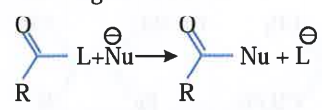Nucleophilic Addition Elimination Reaction : acyl nucleophilic substitution on carboxylic acids and dervatives(SNAE/SNAC)-3) carboxylic acid,4)anhydrides(Symmetrical and unsymmetrical),5)benzene sulphonyl chloride,6) cyanides and isocyanides,7) amides
Step by step video solution for Nucleophilic Addition Elimination Reaction : acyl nucleophilic substitution on carboxylic acids and dervatives(SNAE/SNAC)-3) carboxylic acid,4)anhydrides(Symmetrical and unsymmetrical),5)benzene sulphonyl chloride,6) cyanides and isocyanides,7) amides by Chemistry experts to help you in doubts & scoring excellent marks in Class 12 exams.
Updated on:21/07/2023Similar Questions
Nucleophilic Addition Elimination Reaction : carboxylic acids and derivatives,SNAC or SNAE examples on 1) acis Halides,2) Esters,3) cyclic esters
View SolutionReaction Mechanism : nucleophilic substitution,examples on alcohol,1)lucas reagent,2)socl2,3)pcl3,4)pcl5,5)hi,6)nabr/h2so4,7)tscl
View Solution
Knowledge Check
Nucleophilic substitution at acyl carbon of a carboxylic acid derivative generally proceeds by.
AAddition-elimination mechanismBElimination-addition mechanismCSN1 mechanismDSN2 mechanismAldehyde, ketone, carboxylic acid derivatives contain C= O group. Aldehyde and ketones give nucleophilic addition reactions where as acid and acid derivatives give nucleophilic addition followed by elimination reactions. Nucleophilic addition reactions followed by elimination of acid dervatives is Known sacyl substitution reaction. This substitution reaction takes place by formation of tetrahedral intermediate. For the given reaction

which of these is correct ?AL must be better leaving group than NuBNu− must be strong enough nucleophile to attack carbonyl carbonCCarbonyl carbon must be enough electrophilic to react with Nu−Dall of these
Reaction Mechanism : grignard reagent, (nucleophilic addition elimination (SNae,SNac), reaction with co2,so3,o2,)
View SolutionReaction OF Alcohol with Pcl3,Pcl5 ||Reaction OF Pcl5 with Ether, Ketone, Carboxylic Acid Ester, Anhydride and Amide
View SolutionAldehyde, ketone, acid and acid derivatives contain >C=O group. Aldehyde and ketones gives nucleop addition reactions where as acid and acid derivatives gives nucleophilic addition followed by ellmination reaction Nucleophilic addition reactions followed by ellimination of acid derivatives is known as acyl substitution reacts This subsitution reaction takes places by formation of tertrahedral intermediate. For the given reaction
_E01_571_Q01.png)
which of these is correct?
View SolutionAldehydes and ketones undergo nucleophilic addition reactions. With weak nucleophiles such as ammonia and its derivatives, (H2N−Z), aldehydes and ketones react in weakly acidic medium to form compounds containing carbonnitrogen double bond with the elimination of water to form
 . Aldehydes can be easily oxidised to carboxylic acid on treatment with common oxidising agents like KMnO4K2Cr2O7,HNO3, etc. The carboxylic acid formed contain the same number of carbon atoms as the aldehydes. However ketones under drastic conditions with powerful oxidising agents undergo cleavage of C-C bond giving mixture of carboxylic acids having lesser number of C atoms than the original ketone.
. Aldehydes can be easily oxidised to carboxylic acid on treatment with common oxidising agents like KMnO4K2Cr2O7,HNO3, etc. The carboxylic acid formed contain the same number of carbon atoms as the aldehydes. However ketones under drastic conditions with powerful oxidising agents undergo cleavage of C-C bond giving mixture of carboxylic acids having lesser number of C atoms than the original ketone.
Arrange the following in the decreasing order of their reactivity towards HCN:
HCHo,CH3COCH3,CH3CHO,C6H5CHO
View SolutionAldehydes and ketones undergo nucleophilic addition reactions. With weak nucleophiles such as ammonia and its derivatives, (H2N−Z), aldehydes and ketones react in weakly acidic medium to form compounds containing carbonnitrogen double bond with the elimination of water to form
 . Aldehydes can be easily oxidised to carboxylic acid on treatment with common oxidising agents like KMnO4K2Cr2O7,HNO3, etc. The carboxylic acid formed contain the same number of carbon atoms as the aldehydes. However ketones under drastic conditions with powerful oxidising agents undergo cleavage of C-C bond giving mixture of carboxylic acids having lesser number of C atoms than the original ketone.
. Aldehydes can be easily oxidised to carboxylic acid on treatment with common oxidising agents like KMnO4K2Cr2O7,HNO3, etc. The carboxylic acid formed contain the same number of carbon atoms as the aldehydes. However ketones under drastic conditions with powerful oxidising agents undergo cleavage of C-C bond giving mixture of carboxylic acids having lesser number of C atoms than the original ketone.
Write the reaction of acetone with semicarbazide.
View SolutionAldehydes and ketones undergo nucleophilic addition reactions. With weak nucleophiles such as ammonia and its derivatives, (H2N−Z), aldehydes and ketones react in weakly acidic medium to form compounds containing carbonnitrogen double bond with the elimination of water to form
 . Aldehydes can be easily oxidised to carboxylic acid on treatment with common oxidising agents like KMnO4K2Cr2O7,HNO3, etc. The carboxylic acid formed contain the same number of carbon atoms as the aldehydes. However ketones under drastic conditions with powerful oxidising agents undergo cleavage of C-C bond giving mixture of carboxylic acids having lesser number of C atoms than the original ketone.
. Aldehydes can be easily oxidised to carboxylic acid on treatment with common oxidising agents like KMnO4K2Cr2O7,HNO3, etc. The carboxylic acid formed contain the same number of carbon atoms as the aldehydes. However ketones under drastic conditions with powerful oxidising agents undergo cleavage of C-C bond giving mixture of carboxylic acids having lesser number of C atoms than the original ketone.
Name the product obtained when pentan-2-one is oxidised with conc. HNO3
View Solution
